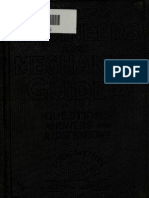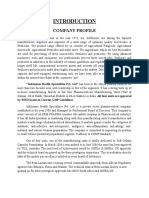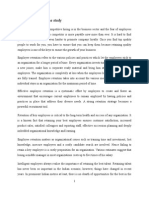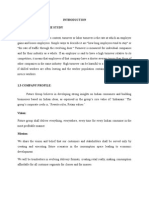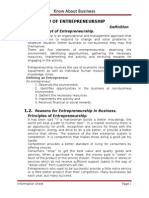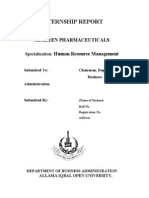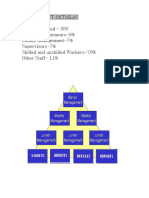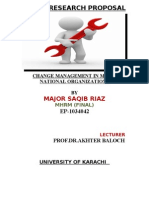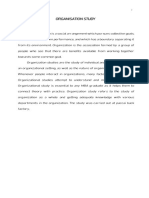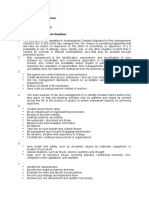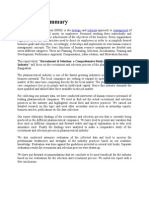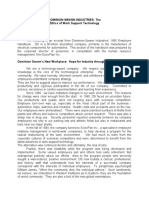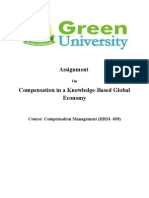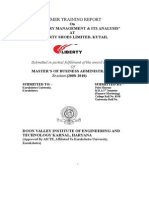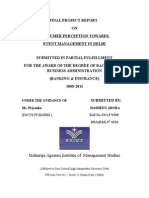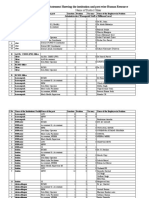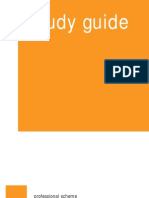About Company
About Company
Uploaded by
dk6666Copyright:
Available Formats
About Company
About Company
Uploaded by
dk6666Original Description:
Original Title
Copyright
Available Formats
Share this document
Did you find this document useful?
Is this content inappropriate?
Copyright:
Available Formats
About Company
About Company
Uploaded by
dk6666Copyright:
Available Formats
About Company
COMPANY PROFILE
Indchemie Health Specialities Pvt. Ltd. is a private sector pharmaceutical
company, established in the year 1986 and Manaed by Pro!essional "oard o!
#irectors. $his company is sister concern o! ALKEM PHARMA %number 6
th
ran&ed
company in Pharmaceutical industry'. It has all India operation in mar&etin alon
(ith !our manu!acturin units. $(o are established at #aman, and one each at "addi
and Si&&im. It manu!actures and mar&ets a (ide rane o! pharmaceutical
!ormulations. It mar&ets enerics under the cateories o! antibiotic, anti)in!ective,
anti)osteoporotic, analesics, anti)in!lammatory, anti)allery, anti)malarial, and
various vitamin preparations. $he company is committed to improvin its position in
small volume parenteral preparations sement. It adheres to c*MP standards.
Details
Company Name : Indchemie Health Specialities Pvt. Ltd.
Addess : +1,, Shah -ahar Industrial .state, #r. .. Moses /d, 0orli
-a&a
Le!el o" O""i#e : Head 1!!ice
P$one No : %22' 3,4,,8,,
%ebsite : (((. indchemie.in
Industy : Pharmaceuticals5 "io$ech5 /esearch
City : Mumbai
&tate : Maharashtra
Company 'ype : Industry "est
No( o" Employees : +,1)1,,,
&e#to : Private Sector
RE&EARCH ) DE*ELOPMEN'
Indchemie Health Specialties has rein!orced its !ocus on /6# and has
substantially scaled up on its investments to build its capabilities in all the areas o!
eneric research as a short to medium term stratey. *eneric dru development
encompasses both small and lare molecules. Indchemie Health Specialties stronly
believes that there are attractive opportunities in the hihly competitive lobal
eneric space, not only in vanilla enerics but also in value added and di!!icult to
develop comple7 enerics. $he business !ocus is bac&ed (ith the buildin up o!
captive manu!acturin operations and o! complyin (ith the reulatory standards o!
the advanced mar&ets. 8ocus on the enerics business stratey (ill provide the
company (ith a sustainable model to move up the value chain. $oday, the company
includes a roup o! more than 2,, /6# scientists, (ith per!ormance driven
credentials, in all the disciplines o! eneric dru development, as their asset to steer
!or(ard in its current aspirations.
Indchemie Health Specialties eneric dru development meets the speed and
9uality attributes, as all the elements o! research have been conducted (ithin the
campus. "ac&(ard interation throuh in)house :PI development and !ront)end
e!!icient mar&etin5distribution o! products (ould provide the desired impetus to the
enerics proram !rom lab scale development to commerciali;ation.
Indchemie Health Specialties has committed a substantial amount o! its
resources to the development o! -ovel #ru #elivery Systems and this shall be the
&ey element in providin momentum to consolidate its ob<ective o! value addition.
Indchemie Health Specialties has an aspiration to ma&e pioneer (ithin the
area o! dru discovery, sometime in the recent !uture, and is loo&in into various
models and therapeutic sements to carve out a meanin!ul space in the arena o!
medical needs that are not !ul!illed. Indchemie Health Specialities has in)licensed a
number o! novel products !or the domestic mar&et, !orm overseas collaborators, and
continue to do so to provide the most advanced therapy avenues to the Indian
patients.
Indchemie Health Specialties is also collaboratin (ith several Indian
companies !or their development o! di!!icult)to)ma&e products and the development
o! other uni9ue technoloies. Indchemie Health Specialties is proressin (ith leaps
and bounds in the -utraceutical sement o! healthcare and (ellness. -utraceutical
/6# e!!orts are mainly directed to(ards providin lo( !at and lo( calorie
nutritional products !or the better manaement o! health. =ommendable success has
been achieved in this area o! research and development. Indchemie Health
Specialities is buildin its !uture upon appropriate and timely protection o! its /6#
e!!orts. : number o! patent applications are emerin !rom the in)house innovations
(hich have one on to be !iled.
Indchemie Health Specialties has state o! the art manu!acturin !acility
located Mumbai to carry out most advance research. /esearch at Indchemie Health
Specialties is uided a seasoned top team supported by over 2,, scientist (or&in
on challenin assinments. Indchemie Health Specialities ) /6# has inherent
strenth in analytical chemistry and speciali;ation in creatin hih 9uality
!ormulations as per the re9uired speci!ications.
O'HER INFORMA'ION&
DEPAR'MEN'&
1' #istribution #epartment,
2' 8inance #epartment,
3' H./ #epartment,
4' Sales and :dministration department alon (ith Mar&etin 6 Sales.
MAN+FAC'+RIN, DONE FOR &OME POP+LAR COMPANIE& LIKE
1' $orrent
2' #r /eddys
3' Hetero
4' =atchet and :lembic etc.
COMPANY -+&+NE&&
=ompany turnover is about 2+, > +,, crs.
Its manu!acturin capacity is 1+, crs.
RECR+I'MEN' AND INCEN'I*E POLICY
/ecruitment in the company is done by department heads o! respective
department and !inal recruitment done by Honourable director M. ?. Sinh.
In sales, incentive based on per!ormance) (ith overall achievement o! taret,
volume (ise and unit (ise.
Intodu#tion
REA&ON& 'O CHOO&E 'HE PRO.EC'
0hen I <oined the trainin at INDCHEMIE HEAL'H &PECIALI'IE& P*'(
L'D(/ I (as allotted the pro<ect o! @A-&EN'EEI&M OF EMPLOYEE&0( Initially
it appeared to me 9uite a simple pro<ect, but as I started (or&in on it only then I
understood its real sini!icance.
It is o!ten easier !or the orani;ations to ma&e arranement to cover sta!!s,
(hich are oin to be o!! !or lon periods. Ho(ever, employees ta&in odd days o!!
here and there are more problematic, can have an immediate impact.
I! remain unchec&ed, this type o! absence can send out the (ron sinals to
colleaues (ho, in some <obs, are li&ely to have to cover !or those absent. I!
employers !ail to ta&e action, a Abuins turnB mentality may emere. 8re9uent
absence may have serious repercussions (here sta!! are employed in customer)!acin
roles or employed on production lines. $he impact o! absence may be most directly
!elt and the need to arrane cover at short notice may be paramount.
A-&EN'EEI&M
CONCEP' OF A-&EN'EEI&M
It re!ers to (or&ers absence !rom their reular tas& (hen he is normally
schedule to (or&. $he accordin to 0ebsterBs dictionary
@:bsenteeism is the practice or habit o! bein an absentee and an absentee is
one (ho habitually stays a(ay !rom (or&.C
:ccordin to Labour "ureau o! Shimla D ) :bsenteeism is the total man shi!ts
lost because o! absence as percentae o! total number o! man shi!ts scheduled to
(or&.
In other (ords, it sini!ies the absence o! an employee !rom (or& (hen he is
scheduled to be at (or&. :ny employee may stay a(ay !rom (or& i! he has ta&en
leave to (hich he is entitled or on round o! sic&ness or some accident or (ithout
any previous sanction o! leave. $hus absence may be authorised or unauthorised,
(il!ul or caused by circumstances beyond oneBs control.
Maybe even (orse than absenteeism, it is obvious that people such as
malinerers and those un(illin to play their part in the (or&place can also have a
decidedly neative impact.
Such team members need individual attention !rom !rontline supervisors and
manaement.
Indeed, as prevention is better than cure, (here such a problem occurs, it is
al(ays important to revie( recruitment procedures to identi!y ho( such individuals
came to be employed in the !irst place.
8or any business o(ner or manaer, to cure e7cessive absenteeism, it is
essential to !ind and then eliminate the causes o! discontent amon team members.
I! they !ind their supervisor or <ob unpleasant ) really unpleasant ) they loo&
!or leitimate e7cuses to stay home and !ind them (ith thins such as upset
stomachs or splittin headaches.
:ny e!!ective absentee control proram has to locate the causes o! discontent
and modi!y those causes or eliminate them entirely. In other (ords, i! (e deal (ith
the real reasons team members stay home it can become unnecessary !or them to
stay a(ay.
:ny investiation into absenteeism needs to loo& at the real reasons !or it.
Sometimes team members call in sic& (hen they really do not (ant to o to
(or&. $hey (ould not call you up and say, @IBm not comin in today because my
supervisor abuses me.C
1r, @IBm not comin in today because my chair is uncom!ortable.C 1r, @IBm
not comin in today because the bathrooms are so !ilthy, it ma&es me sic& to (al&
into them.C
$here are a !e( essential 9uestions to consider at the outset i! you (ant to
ma&e a measurable improvement to your absenteeism !iures.
0hy is your present absenteeism policy ine!!ectiveE
0here and (hen is e7cessive absenteeism occurrinE In many cases, under)
trained supervisors could be a contributin !actor.
0hat are the real causes !or absencesE
It is commonly e7pected that lo( pay, poor bene!its and hih (or&loads (ill
be the ma<or causes.
Ho(ever, in numerous employee surveys absenteeism enerally has been
identi!ied as a symptom o! lo( <ob satis!action, sub)standard (or&in conditions
and consistent neative and un!air treatment received by !irst)line supervisors.
Ho( much !ormal trainin have your supervisors received on absenteeism
containment and reductionE I! your ans(er is none or very little, maybe you have
!ound the solution.
:s (ith every other element (ithin your orani;ation, you cannot as& a person
to do a <ob he or she has never been trained to do.
Many human resources specialists have !ound that repetitive, borin <obs
coupled (ith uncarin supervisors and5or physically unpleasant (or&places are
li&ely to lead (or&ers to ma&e up e7cuses !or not comin to (or&.
I! your team members perceive that your company is indi!!erent to their needs,
they are less li&ely to be motivated, or even to cloc& on at all.
1ne (ay to determine the causes o! absenteeism is to 9uestion your
supervisors about e7cessive absenteeism, includin (hat causes it and ho( to
reduce it.
1! course, i! your supervisors have made no e!!orts to et to &no( the team
members in their respective departments, they may not be able to provide reasons.
Ho(ever, <ust the act o! 9uestionin may et the ball rollin and sinal to
your supervisors that their involvement is important.
1nce a manaer !inds the real reasons !or absenteeism there is another
important step. $hrouh open communication, you need to chane the team
memberBs (ay o! reactin and respondin to discontent.
1ther problems (ill no doubt arise in the !uture. I! the (ay o! respondin has
not been revie(ed, then the same cycle is li&ely to start all over aain.
So o!ten absenteeism problems can be sheeted bac& to the supervisor level and
to unsatis!actory (or&in conditions. 0ithout improvement in these areas, you can
e7pect your hih rate o! absenteeism to continue.
MEA&+REMEN' OF A-&EN'EEI&M
8or calculatin the rate o! absenteeism (e re9uire the number o! people
scheduled to (or& and number o! people actually present. :bsenteeism can be !ind
out o! absence rate method.
For ExampleD
a' :verae number o! employees in (or& !orce D 1,,
b' -umber o! available (or&days durin period D 2,
c' $otal number o! available (or&days %a 7 b' D 2,,,,
d' $otal number o! lost days due to absences durin the period D 93
e' :bsenteeism percent %d Fdivided byG c' 7 1,, D 4.6+H
Since absenteeism is a ma<or barometer o! employee morale,
absenteeism above + percent has to be considered as very serious %across most
industries 3 percent is considered standard'.
A-&EN'EEI&M RA'E A'
INDCHEMIE HEAL'H &PECIALI'IE& P*'( L'D(
PEC+LIAR FEA'+RE& OF A-&EN'EEI&M
1n the basis o! studies underta&en certain observations may be madeD
a' $he rate o! absenteeism is lo(est on paydayI it increases considerably on the
days !ollo(in the payment o! (aes and bonus. $he level o! absenteeism is
comparatively hih immediately a!ter payday. 0hen (or&er either !eel li&e
havin a ood time or in some other cases return home to their villaes !amily
and a!ter a holiday, has also been !ound to be hiher than that on normal days.
b' :bsenteeism is enerally hih (or&ers belo( 2+ years o! ae and those above
4,. @$he youner employees are not reular and punctualC. Presumably because
o! the employment o! a lare no. o! ne( comers amon the youner ae roups,
(hile the older people are not able to (ithstand the strenuous nature o! the
(or&.
c' $he percentae o! absenteeism is hiher in the niht shi!t than in the day shi!t.
$his is so because (or&ers in the niht shi!t e7perience reat discom!ort and
uneasiness in the course o! their (or& than they do durin day time.
d' :bsenteeism in India is seasonal in character. It is the hihest durin March)
:pril)May, (hen land has to be prepared !or monsoon, so(in and also in
harvest season %Sept)1ct' (hen the rate oes as hih as 4,H.
CA+&E& OF A-&EN'EEI&M
$he /oyal =ommission Labour observed that hih absenteeism amon Indian
labour is due to rural orientation and their !re9uent ure !or rural e7odus. :ccordin
to :charaya @In modern industrial establishment the incidence o! industrial !atiue,
mal nutrition and bad (or&in conditions aravate that !eelin !or chane amon
industrial (or&er and some time impel them to visit their villae home !re9uently
!or rest and rela7ation.C
$he eneral cause o! absenteeism may be summarised as belo(D)
12 MALAD.+&'MEN' %I'H FAC'ORY
In !actory the (or&er !inds cauht (ithin !actory (alls, he is be(ildered by
heavy tra!!ic, by straners spea&in di!!erent and sub<ected to strict discipline
and is ordered by complete straners to do thins (hich he cannot understand.
:s a result he is under constant strain, (hich cause him serious distress and
impairs his e!!iciency. :ll these !actors tend to persuade him to maintain his
contacts (ith villae.
32 &OCIAL AND RELI,IO+& CEREMONIE&
Social and reliious ceremonies divert (or&ers !rom (or&ers to social
activities. In lare number o! cases incidence o! absenteeism due to reliious
ceremonies is more than due to any other reason.
42 HO+&IN, CONDI'ION&
0or&ers also e7perience housin di!!iculties. :round 9+H o! housin
occupied by industrial (or&ers in India is unsatis!actory !or health!ul
habitations. $his leads to loss the interest in (or&.
52 IND+&'RIAL FA'I,+E
Lo( (aes compel a (or&er to see& some part time <ob to earn some side
income. $his o!ten result inconstant !atiue, (hich compels to remain absent
!or ne7t day.
62 +NHEAL'Y %ORKIN, CONDI'ION
Irritatin and intolerable (or&in conditions e7ist in a !actory. Heat, moisture,
noise, vibration, bad lihtin, dust !umes and overcro(din all these a!!ect the
(or&ers health causin him to remain absent !rom (or& a lon time.
72 A-&ENCE OF ADE8+A'E %ELFARE AC'I*I'IE&
Hih rate absenteeism is also due to lac& o! ade9uate (el!are !acilities
0el!are activities include clean drin&in (ater, canteen, room shelter, rest
rooms, (ashin and bathin !acilities, !irst aid appliances etc.
92 ALCOHOLI&M
Some o! the habitual drun&ards spend (hole o! their salary durin !irst (ee&
o! each month !or drin&in purpose. $here!ore 2 or 3 (ee&s a!ter ettin their
salary absent themselves !rom their (or&.
:2 INDE-'NE&&
:ll those (or&ers (ho undero !inancial hardships usually borro( money
lenders at interest rate (hich are very hih, (hich o!ten cumulates to more
than 11 > 12 times their actual salaries. $o avoid the moneylenders they
usually absent themselves !rom (or& because they are unable to return the
money in stipulated time.
;2 IMPROPER ) +NREALI&'IC PER&ONNEL POLICIE&
#ue to !avouritism and nepotism (hich are in the industry the (or&ers
enerally become !rustrated. $his also results in lo( e!!iciency, lo(
productivity, un!avourable relationship bet(een employee and supervisor,
(hich in turn leads to lon period o! absenteeism.
1<2 INADE8+A'E LEA*E FACILI'IE&
-elience on part o! the employee to provide leave !acility compel the
(or&er to !all bac& on .SI leave. $hey are entitled to +, days leave on hal! on
pay. Instead o! oin (ithout pay the (or&er avail themselves o! .SI !acility
EFFEC'& OF A-&EN'EEI&M ON IND+&'RIAL PRO,RE&&
It is 9uite evident !rom the above !iures that absenteeism is a common
!eature o! industrial labour in India. It hinders industrial ro(th and its e!!ect in t(o
!old.
12 LO&& 'O %ORKER
8irstly due to the habit o! bein absentin !re9uently (or&erBs income
is reduced to a lare e7tent. It is because there is a eneral principle o! @no
(or& > no payC. $hus the time lost in terms o! absenteeism is a loss o! income
to (or&ers
32 LO&& 'O EMPLOYER&
1n other hand, the employer has to su!!er a reater loss due to
absentees. It disturbs the e!!iciency and discipline o! industries conse9uently,
industrial production is reduced. In order to meet the emerency and stri&es,
an additional labour !orce is also maintain by the industries. 1n certain
occasions, those (or&ers are employed (ho present themselves at !actory
ates. #urin stri&es they are ad<usted in place o! absent (or&ers. $heir
ad<ustment brins serious complications because such (or&ers do not
enerally prove themselves up to (or&. Hiher absenteeism is an evil both !or
(or&ers and the employers and ultimately it adversely a!!ects the production
o! industries.
ANALY&I& OF CA+&E&
12 FAMILY ORIEN'ED ) RE&PON&I-ILI'E&
It (as observed that about 4,H case absenteeism is !amily oriented and more
responsibilities o! (or&ers. It increases in harvestin season.
2) &OCIAL CEREMONIE&
In 2, H cases it (as !ound that social and reliious !unctions divert (or&er
!rom (or&.
42 HO+&IN, FACILI'Y
In about 3,H cases, the (or&ers remain absent because there is no housin
!acilities and the (or&ers stay alone and reat distance !rom !actory.
52 &ICKNE&& AND ACCIDEN'
In 2,H case the (or&ers remain absent due to ill health and disease and in
1+H cases (or&ers remain absent due to accident.
62 'RAN&POR'A'ION
Most o! the (or&ers have to travel lon distance to reach the (or& place. Most
o! the (or&ers are not satis!ied (ith transport !acilities.
6) %ELFARE FACILI'E&
In 13H cases, the (or&ers are not satis!ied (ith (el!are !acilities.
92 %ORKIN, CONDI'ION&
In 21H cases, the (or&ers !eel that there is not ood (or&in condition,
because they (or& in standin position (hich causes to remain absence !or
rela7ation.
:2 MANA,EMEN' &Y&'EM
-ear about 34H people are dissatis!ied (ith manaement system because they
!eel that their (or& is not bein reconised and promotions are biased.
A-&EN'EEI&M = 'YPE& ) 'HEIR CON'ROL
$here are t(o types o! absenteeism, each o! (hich re9uires a di!!erent type o!
approach.
1( INNOCEN' A-&EN'EEI&M
Innocent absenteeism re!ers to employees (ho are absent !or reasons beyond
their controlI li&e sic&ness and in<ury. Innocent absenteeism is not culpable (hich
means that it is blameless. In a labour relations conte7t this means that it cannot be
remedied or treated by disciplinary measures.
3( C+LPA-LE A-&EN'EEI&M
=ulpable absenteeism re!ers to employees (ho are absent (ithout
authori;ation !or reasons (hich are (ithin their control. 8or instance, an employee
(ho is on sic& leave even thouh he5she is not sic&, and it can be proven that the
employee (as not sic&, is uilty o! culpable absenteeism. $o be culpable is to be
blame(orthy. In a labour relations conte7t this means that proressive discipline can
be applied.
8or the lare ma<ority o! employees, absenteeism is leitimate, innocent
absenteeism (hich occurs in!re9uently. Procedures !or disciplinary action apply only
to culpable absenteeism. Many orani;ations ta&e the vie( that throuh the process
o! individual absentee counsellin and treatment, the ma<ority o! employees (ill
overcome their problems and return to an acceptable level o! reular attendance.
CO+N&ELLIN, INNOCEN' A-&EN'EEI&M
Innocent absenteeism is not blame(orthy and there!ore disciplinary action is not
<usti!ied. It is obviously un!air to punish someone !or conduct (hich is beyond
his5her control. :bsenteeism, no matter (hat the cause, imposes losses on the
employer (ho is also not at !ault. $he damae su!!ered by the employer must be
(eihed aainst the employeeJs riht to be sic&. $here is a point at (hich the
employerJs riht to e7pect the employee to attend reularly and !ul!ill the
employment contract (ill out(eih the employeeJs riht to be sic&. :t such a point
the termination o! the employee may be <usti!ied, as (ill be discussed.
$he procedure an employer may ta&e !or innocent absenteeism is as !ollo(sD
1. Initial counsellin%s'
2. 0ritten counsellin%s'
3. /eduction%s' o! hours and5or <ob reclassi!ication
4. #ischare
Initial Counsellin>
Presumin you have communicated attendance e7pectations enerally and
have already identi!ied an employee as a problem, you (ill have met (ith him or her
as part o! your attendance proram and you should no( continue to monitor the
e!!ect o! these e!!orts on his or her attendance.
I! the absences are intermittent, meet (ith the employee each time he5she returns to
(or&. I! absence is proloned, &eep in touch (ith the employee reularly and stay
updated on the status o! his5her condition. %Indicate your (illinness to assist.'
Kou may re9uire the employee to provide you (ith reular medical assessments. $his
(ill enable you to <ude (hether or not there is any li&elihood o! the employee
providin reular attendance in !uture. /eular medical assessments (ill also ive
you an idea o! (hat steps the employee is ta&in to see& medical or other assistance.
8ormal meetins in (hich verbal (arnins are iven should be iven as appropriate
and documented. I! no improvement occurs (ritten (arnin may be necessary.
%itten Counsellin>
I! the absences persist, you should meet (ith the employee !ormally and
provide him5her (ith a letter o! concern. I! the absenteeism still continues to persist
then the employee should be iven a second letter o! concern durin another !ormal
meetin. $his letter (ould be stroner (orded in that it (ould (arn the employee
that unless attendance improves, termination may be necessary.
Redu#tion?&2 o" Hous and o .ob Re#lassi"i#ation
In bet(een the !irst and second letters the employee may be iven the option
to reduce his5her hours to better !it his5her personal circumstances. $his option must
be voluntarily accepted by the employee and cannot be o!!ered as an ultimatum, as a
reduction in hours is a reduction in pay and there!ore can be loo&ed upon as
discipline.
I! the nature o! the illness or in<ury is such that the employee is unable to !ul!il the
re9uirements o! his5her <ob, but could !or e7ample bene!it !rom modi!ied (or&,
counsel the employee to bid on <obs o! such type i! they become available. %-.". It is
inadvisable to LbuildL a <ob around an employeeJs incapacitates particularly in a
unioni;ed environment. $he onus should be on the employee to apply !or an e7istin
position (ithin his5her capabilities.'
Dis#$a>e
1nly (hen all the previously noted needs and conditions have been met and
everythin has been done to accommodate the employee can termination be
considered. :n :rbitrator (ould consider the !ollo(in in rulin on an innocent
absenteeism dismissal case.
a' Has the employee done everythin possible to reain their health and return to
(or&E
b' Has the employer provided every assistance possibleE %i.e. counsellin,
support, time o!!.'
c' Has the employer in!ormed the employee o! the un(or&able situation resultin
!rom their sic&nessE
d' Has the employer attempted to accommodate the employee by o!!erin a more
suitable position %i! available' or a reduction o! hoursE
e' Has enouh time elapsed to allo( !or every possible chance o! recoveryE
!' Has the employer treated the employee pre<udicially in any (ayE
:s is evident, a reat deal o! time and e!!ort must elapse be!ore dismissal can
ta&e place.
$hese points (ould be used to substantiate or disprove the !ollo(in t(o !old test.
1. $he absences must be sho(n to be clearly e7cessive.
2. It must be proven that the employee (ill be unable to attend (or& on a reular
basis in the !uture.
CORREC'I*E AC'ION FOR C+LPA-LE A-&EN'EEI&M
:s already indicated, culpable absenteeism consists o! absences (here it can
be demonstrated that the employee is not actually ill and is able to improve his5her
attendance.
Presumin you have communicated attendance e7pectations enerally, have
identi!ied the employee as a problem, have met (ith him5her as part o! your
attendance proram, made your concerns on his speci!ic absenteeism &no(n and
have o!!ered counsellin as appropriate, (ith no improvement despite your positive
e!!orts, disciplinary procedures may be appropriate.
$he procedures !or corrective5proressive discipline !or culpable absenteeism
are enerally the same as !or other proressive discipline problems. $he discipline
should not be pre<udicial in any (ay. $he eneral procedure is as !ollo(sD FMtili;in
counsellin memorandumG
1. Initial 0arnin%s'
2. 0ritten 0arnin%s'
3. Suspension%s'
4. #ischare
*ebal %anin>
8ormally meet (ith the employee and e7plain that income protection is to be
used only (hen an employee is leitimately ill. :dvice the employee that his5her
attendance record must improve and be maintained at an improved level or !urther
disciplinary action (ill result. 1!!er any counsellin or uidance as is appropriate.
*ive !urther verbal (arnins as re9uired. /evie( the employeeJs income protection
records at reular intervals. 0here a mar&ed improvement has been sho(n, commend
the employee. 0here there is no improvement a (ritten (arnin should be issued.
%itten %anin>
Intervie( the employee aain. Sho( him5her the statistics and point out that
there has been no noticeable %or su!!icient' improvement. Listen to the employee to
see i! there is a valid reason and o!!er any assistance you can. I! no satis!actory
e7planation is iven, advise the employee that he5she (ill be iven a (ritten
(arnin. "e speci!ic in your discussion (ith him5her and in the counsellin
memorandum as to the type o! action to be ta&en and (hen it (ill be ta&en i! the
record does not improve. :s soon as possible a!ter this meetin provide the employee
personally (ith the (ritten (arnin and place a copy o! his5her !ile. $he (ritten
(arnin should identi!y any noticeable pattern
I! the amount and5or pattern continues, the ne7t step in proressive discipline may be
a second, stroner (ritten (arnin. Kour decision to provide a second (ritten
(arnin as an alternative to proceedin to a hiher level o! discipline %i.e.
suspension' (ill depend on a number o! !actors. Such !actors are, the severity o! the
problem, the credibility o! the employeeJs e7planations, the employeeJs eneral (or&
per!ormance and lenth o! service.
&uspension ?only a"te #onsultation @it$ t$e appopiate supeios2
I! the problem o! culpable absenteeism persists, !ollo(in the ne7t intervie(
period and immediately !ollo(in an absence, the employee should be intervie(ed
and advised that he5she is to be suspended. $he lenth o! the suspension (ill depend
aain on the severity o! the problem, the credibility o! the employeeJs e7planation,
the employeeJs eneral (or& per!ormance and lenth o! service. Subse9uent
suspensions are optional dependin on the above condition.
Dismissal ?only a"te #onsultation @it$ t$e appopiate supeios2
#ismissals should only be considered (hen all o! the above conditions and
procedures have been met. $he employee, upon displayin no satis!actory
improvement, (ould be dismissed on the rounds o! his5her un(illinness to correct
his5her absence record.
,+IDELINE& ) MEA&+RE& FOR CON'ROL OF A-&N'EEI&M
:bsenteeism is a disease that appears (henever a company !ails to inoculate
itsel! throuh the use o! sound manaement practices. $o cure e7cessive
absenteeism, one has to &no( the e7act causes and then e7amine the available,
(or&able and proven solutions to apply aainst those causes.
$o embar& upon a success!ul absenteeism reduction proram, you need to
ma&e sure you have some basic in!ormation and !acts about absenteeism in your
company. =onsider the !ollo(in !our 9uestions, (hich should help you !urther !ocus
your ideas and put a plan into action.
8. %$y is you pesent absenteeism poli#y ine""e#ti!eA
:bsenteeism policies vary in e!!ectiveness. Most ine!!ective policies I have
revie(ed have a common denominatorD $hey allo( Le7cusedL absences, (hereas
those that do (or& are Lno !aultL policies.
8( %$ee and @$en is eB#essi!e absenteeism o##uin>A
-umerous studies have concluded that under trained supervisors is one o! the
main causes o! absenteeism. $here!ore, any company e7periencin absenteeism o!
reater than 3 percent should consider supervisors as a potential contributor to the
problem.
*iven that this may be the case, you !irst should chec& the percentae o!
employee absenteeism by supervisor to see i! it is concentrated around one or t(o
supervisors. I! it is, youJve beun to uncover the obvious))undertrained supervisors.
I!, ho(ever, your research reveals that the rate o! absenteeism is almost e9ually
distributed throuhout your !actory, you (ill need to investiate other possible
causes.
8( %$at ae t$e eal #auses "o absen#esA
People)oriented companies are very sensitive to employee opinions. $hey o!ten
enae in !ormal mini)studies to solicit anonymous employee opinions on topics o!
mutual interest. $hese con!idential (or&er surveys commonly as& !or employee
opinion reardin hiher)than)normal absenteeism.
In other (ords, employees revealed that repetitive, borin <obs coupled (ith
uncarin supervisors and5or physically unpleasant (or&places led them to ma&e up
e7cuses !or not comin to (or&, such as claimin to be sic&.
1ne (ay to determine the causes o! absenteeism is to 9uestion your supervisors
about their employeesJ e7cessive absenteeism, includin (hat causes it and ho( to
reduce it.
8( Ho@ mu#$ "omal tainin> $a!e you supe!isos e#ei!ed on absenteeism
#ontainment and edu#tionA
I! you !ind that your supervisors hesitate to provide meanin!ul ans(ers to your
9uestions, then youJre on the riht trac& to(ard a solution. :s& yoursel!, LHo( much
!ormal trainin have I iven my supervisors in the areas o! absenteeism reduction
and human resources s&illsEL I! your ans(er is none or very little, your solution canJt
be !ar behind. $he !act o! the matter is, you cannot as& a person to do a <ob he or she
has never been trained to do.
Follo@in> ae t$e measues to #ontol absenteeism:=
12 ADOP'ION OF A %ELL DEFINED RECR+I'MEN' PROCED+RE
$he selection o! employees on the basis o! command, linuistic and !amily
consideration should be avoided. $he manaement should loo& !or aptitude
and ability in the prospective employees and should not easily yield or
pressure o! personal li&es and disli&es. :pplication blan&s should invariably
be used !or a preliminary selection and tools !or intervie(s. $he personal
o!!icer should play more e!!ective role as coordinator o! in!ormation, provided
that he has ac9uired <ob &no(lede in the !unction o! selection. .mployers
should also ta&e into account the !act that selection should be !or employeeBs
development, their reliance. $hey should as !ar as possible rely on
employment e7chane. .
32 PRO*I&ION OF HEAL'HF+L AND HY,ENIC %ORKIN, CONDI'ION
In India, (here the climate is (arm and most o! the (or& involves manual
labour, it is essential that the (or&ers should be provided (ith proper and
healthy (or&in conditions. $he !acilities o! drin&in (ater, canteens,
lavatories, rest rooms, lihtin and ventilation, need to be improved. 0here
any one o! these !acilities is not available, it should be provided and all these
help in &eepin the employee cheer!ul and increase productivity and the
e!!iciency o! operations throuhout the plant.
42 PRO*I&ION OF REA&ONA-LE %A,E& AND ALLO%ANCE AND .O-
&EC+RI'Y 'O %O'RKER&
$he (aes o! an employee determine his as (ell as his !amily standard o!
livin. $his sinle !actor is important !or him than other. $he manaement
should, there!ore pay reasonable (aes and allo(ances, ta&in into account
the capacity o! the industry to pay.
52 MO'I*A'OR& %ELFARE AND &OCIAL MEA&+RE&
$he manaement should consider the needs o! (or&ers and o!!er them
ade9uate and cheap housin !acilities, !ree o! subsidised !ood, !ree medical
and transport !acilities, !ree education !acilities !or their children and other
monetary bene!its. :s !or social security is concern, the provision o!
Provident 8und, S"I !acilities, *ratuity and Pension, all those need to be
improved.
62 IMPRO*ED COMM+NICA'ION AND PROMP' REDRE&&AL OF
,RIE*ANCE&
Since a ma<ority o! the (or&ers are illiterate or not hihly educated bulletins
and (ritten notices <ournals and boo&lets are not easily understood by them.
Meetins and concealin are called !or (ritten communication becomes
meanin!ul only (hen (or&ers can readied understood them, too many notices
should be avoided only the essential ones should be put on the boards, (hich
should be placed near the entrance inside the canteen and in areas (hich are
!re9uently visited by the (or&ers so that they are a(are o! the policies o! the
company and any sort chanes bein made.
72 LI-ERAL ,RAN' OF LEA*E
$he manaementBs strict attitude in rantin leave and holidays even (hen the
need !or them is enuine, tempts (or&ers to o on ..S.I. leave !or under this
scheme, they can have +6 days leaves in years on hal! pay. :n e!!ective (ay
o! dealin (ith absenteeism is to liberalise leave rules.
92 &AFE'Y AND ACCIDEN' PRE*EN'ION
Sa!ety at (or& can be maintained and accidents can be prevented i! the
manaement tries to eliminate such personal !actors as nelience,
overcon!idence, carelessness, vanity, etc and such material !actori;es
unuarded machinery and e7plosives, de!ective e9uipment and hand tools.
Sa!e methods o! operation should be tauht. In addition consistent and timely
sa!ely instruction, (ritten instructions %manual' in the reional lanuae o!
the area should be iven to the (or& !orce.
:2 CORDIAL RELA'ION& -E'%EEN &+PER*I&OR& AND %ORKER&
$he supervisor should be reconise that industrial (or& is a roups tas& and
cannot be properly done unless discipline is en!orced and maintained. =ordial
relations bet(een the supervisors and these (or&ers are there!ore essential !or
(ithout them, discipline cannot be increased. 1ne o! the conse9uences o!
unhealthy relations bet(een supervisors and subordinates is absenteeism.
;2 DE*ELOPMEN' OF %ORKER& -Y 'RAININ,
$he system o! (or&erBs education should be so desined as to ta&e into
account their educational needs as individuals !or their personal evaluation, as
operatives !or their e!!iciency and advancement, as citi;ens !or happy
interated li!e in the community, as members o! a trade union !or the
protection o! their interests. $he educational prorams accordin to their
national commission on Labour should be to ma&e a (or&erD)
a' : responsible, committed and disciplines operative.
b' :(are o! his rihts and obliations.
c' Lead a calm, clean and health li!e, based on a !irm ethical !oundation.
d' : responsible and alter citi;en.
'HE -RADFORD FAC'OR ) A-&EN'EEI&M
$he "rad!ord 8actor is a Human /esources tool used by many orani;ations to
measure and identi!y areas o! absenteeism. $he theory is that short, !re9uent and unplanned
absences are more disruptive than loner absences.
It is based on the !act that it is normally easier to ma&e arranements to cover !or
sta!!s (ho are oin to be o!! !or lon periods, and (hich are more li&ely to be su!!erin !rom
a enuine illness.
Ho(ever, employees ta&in odd unplanned days o!! here and there actually cause
more disruption to the business. I! this pattern is repeated reularly, the employee (ill have a
hih "rad!ord 8actor scoreI (hich may raise 9uestions about ho( enuine the illness actually
is.
$he !ormula !or the "rad!ord 8actor isD
. 7 . 7 # N "rad!ord 8actor Score
0here . is the number o! episodes o! absence and # is the total number o! days
absent in a rollin +2 (ee& period.
So, !or employees (ith a total o! 1, days absence in one year, the "rad!ord 8actor
score can vary enormously, dependin on the number o! episodes o! absence involved. 8or
e7ampleD
1ne absence episode o! 1, days is 1, points %i.e. 1 7 1 7 1,'
8ive absence episodes o! t(o days each is 2+, points %i.e. + 7 + 7 1,'
$en absence episodes o! one day each is 1,,,, points %i.e. 1, 7 1, 7 1,'
Ho@ do o>aniCations use t$e -ad"od Fa#toA
$here are no set rules !or usin the "rad!ord 8actorI it is do(n to each orani;ation to
determine the (ays in (hich it uses the score.
Ho(ever, used e!!ectively, the "rad!ord 8actor can reduce absenteeism dramatically,
servin as a deterrent and a method !or tac&lin persistent absenteeism.
Studies have sho(n that by educatin sta!! about the "rad!ord 8actor, and then
sho(in them their score on a reular basis, absenteeism can be reduced by over 2,H. $his is
larely do(n to sta!! understandin that ta&in the odd day o!! here and there (ill 9uic&ly
multiply their "rad!ord 8actor score. $he "rad!ord 8actor places a value on the absence
(hich an employee can clearly see. 0here the absence is not absolutely necessary, this can
serve to deter absenteeism.
0hen this is used in con<unction (ith a points system the "rad!ord 8actor can be
e!!ectively utili;ed to deter unnecessary absenteeism.
8or e7ample the "rad!ord 8actor can be utili;ed by creatin @triersC (hereby
certain actions are ta&en (hen an employeeBs "rad!ord score reaches a certain point. 8or
e7ample, the M? Prison Service has used the !ollo(in triersD
+1 points > verbal (arnin.
2,1 points > (ritten (arnin
4,1 points > !inal (arnin
6,1 points > dismissal
Settin these triers is entirely dependent on the orani;ation usin the "rad!ord
8actor. It is usually advisable to use the "rad!ord 8actor as one o! a number o! absence
policies. Ho(ever, settin these triers and ma&in sta!! a(are o! them, in addition to ta&in
action, resulted in the Prison Service reducin absenteeism by 18H.
"y implementin mandatory procedures !or tac&lin absenteeism across an
orani;ation led by the "rad!ord 8actor, an orani;ation can remove the potential !or
di!!erences across teams and manaement and remove the di!!iculties and reluctance that line
manaers o!ten !ace (hen havin to discipline a close sta!! member.
$he "rad!ord 8actor can provide orani;ations (ith a t(o proned method !or tac&lin
absenceD proactively deterrin absence in the !irst place and utili;in a set procedure to
identi!y and tac&le persistent absenteeism.
Implementin> t$e -ad"od Fa#to
=alculatin the "rad!ord 8actor !or one member o! sta!! over a iven period is not a
di!!icult proposition. Ho(ever, calculatin the "rad!ord 8actor over a rollin +2 (ee& period,
across multiple teams and locations and considerin di!!erent types o! absence is a very
di!!icult tas&.
:s a result o! the e7ponential nature o! the !ormula O. 7 . 7 #P, even the slihtest
mista&es in calculation can result in a (ide variance o! an employeeBs "rad!ord 8actor score.
Fo eBample: 8or an employee (ho has had 1, days o!! in a year in total, on t(o separate
occasionsD
2 Q 2 Q 1, N 4, O(hich does not trier a (arnin > !e(er than +,P
Ho(ever, i! their absence is either not recorded correctly, or is calculated (ron by
<ust one dayD
3 Q 3 Q 1,N 9, O(hich does trier a (arnin > over +,P
Kou can see that their score is more than double, despite the small mista&e. *ettin the
!ormula the (ron (ay round can have even more sini!icant resultsD
1, Q 1, Q 2 N 2,, O(hich (ould trier disciplinary proceedins > over 2,,P
I! an orani;ation (ants to tac&le absenteeism e!!ectively, usin the "rad!ord 8actor,
includin usin an employeeBs "rad!ord 8actor score in potential disciplinary proceedins,
then the process !or calculatin the "rad!ord 8actor has to be !ull proo!, consistent and e9ual.
'o a#$ie!e t$is/ an o>aniCation @ill need to ensue:
Absen#e epotin> and monitoin> is #onsistent/ eDual and a##uate bot$ o!e
time and a#oss t$e @$ole o>aniCation(
'$e #al#ulation o" an employeeEs -ad"od Fa#to s#oe is based on t$ese
a##uate/ eDual and updated absen#e e#ods(
Mana>ement and sta"" $a!e a##ess to updated -ad"od Fa#to s#oes(
0ithout these processes in place the calculation o! the "rad!ord 8actor is e7tremely
di!!icult and time consumin. In addition to thisI une9ual processes !or reportin and
calculatin the "rad!ord 8actor could be discriminatoryI everyoneBs "rad!ord 8actor score
should be sub<ect to the same, indisputable criteria.
RE&EARCH ME'HODOLO,Y
RE&EARCH ME'HODOLO,Y
$he research reveals that one o! the ma<or problems is
absenteeism in our industry. :bsenteeism hinders plannin, production,
e!!iciency and !unctionin o! the oranisation. In !act hih rates o!
absenteeism a!!ect an oranisation state o! health and also supervisory and
manaerial e!!ectiveness.
12 O-.EC'I*E& OF RE&EARCH
i. $o identi!y the rate o! absenteeism o! @(or&erC.
ii. $o identi!y the causes o! absenteeism.
iii. $o suest any measures to reduce the rate o! absenteeism
32 &LE &ELEC'ION AND &IFE
$he population !or the study comprised o! absentees !or current year, the total
sample +, (or&ers.
42 DA'E COLLEC'ION AND &'A'I&'ICAL 'OOL&
$he sources o! data !or the purpose o! study (ere both primary and secondary.
Primary data (as collected throuh 9uestionnaire (hich (as mainly close)
ended 9uestionnaire and discussion (ith (or&ers (hereas secondary data (as
collected !rom records maintained by personal department and time o!!ice.
Percentae method is used !or the analysis o! data and bar raphs are used to
present that data.
LIMI'A'ION OF 'HE &'+DY
$here are some limitations !or research (hich are as !ollo(sD)
a' :s it (as not possible to visit each department the true picture o! (or&in
condition could not be <uded.
b' $he (or&ers (ere busy (ith their (or& there!ore they could not ive enouh
time !or the intervie(.
c' $he personal biases o! the respondents miht have entered into their response.
d' Some o! the respondents ive no ans(er to the 9uestions (hich may a!!ect the
analysis.
e' /espondents (ere reluctant to disclose complete and correct in!ormation
"ecause o! a small period o! time only small sample had to be considered (hich
doesnBt actually re!lect and accurate and intact picture.
ANALY&I&
)
IN'ERPRE'A'ION
DATA ANALYSIS AND INTERPRETATION
Q. GENDER WISE CLASSIFICATION OF RESPONDENTS
TABLE 5.1
S.N Gen
der
No.
of
responde
nts
Per
ent!"e
1 Male 83 66.4
2 Fem
ale
43 33.6
GENDER WISE CLASSIFICATION OF RESPONDENTS
C#ART 5.1
INTERPRETATION:
Majority of re!o"#e"t are more t$e" female re!o"#e"t.
Q. AGE WISE CLASSIFICATION OF RESPONDENTS
TABLE 5.$
S.N A"e No.
of
Per
responde
nts
ent!"e
1 %elo
& 2'
3 2.4
2 2'(
3'
13 1).4
3 3'(
4'
*8 62.4
4 4'(
''
31 24.8
AGE WISE CLASSIFICATION OF RESPONDENTS
C#AT 5.$
INTERPRETATION:
T$e 62.4+ of re!o"#e"t, a-e .et&ee" 3'(4'/ 24.8+ of
re!o"#e"t, a-e .et&ee" 4'(''/ 1).4+ of re!o"#e"t, a-e .et&ee" 2'(
3'/ 2.4+ of re!o"#e"t, a-e i .elo& 2'.
Q. CLASSIFICATION OF T#E RESPONDENT BASED ON T#EIR
DEPART%ENT
TABLE 5.&
S.N Dep
!rt'ent
No.
of
responde
nts
per
ent!"e
1 Pro#
01tio"
3) 24.)
2 Pa12
i"-
83 *1.2
3 Mai"
te"a"1e
6 4.8
CLASSIFICATION OF T#E RESPONDENT BASED ON T#EIR
DEPART%ENT
C#ART 5.&
INTERPRETATION:
T$e *1.2+ of re!o"#e"t &or2i"- i" !a12i"- #e!artme"t/
24+ of re!o"#e"t &or2i"- i" !ro#01tio" #e!artme"t/ 4.8+ re!o"#e"t
&or2i"- i" mai"te"a"1e #e!artme"t.
Q. CLASSIFICATION OF T#E RESPONDENTS BASED ON T#EIR
%ONT#LY INCO%E
TABLE 5.(
S
.N
%o
nt)*+
,no'e
No.
of
responde
nts
Pe
rent!"
e
Rs.
1 %el
o& 2)))
2 1.
6
2 2))
)(4)))
8 6.
4
3 4))
)(6)))
6' '2
4 A.o
4e
4mem.er
') 4)
CLASSIFICATION OF T#E RESPONDENTS BASED ON T#EIR
%ONT#LY INCO%E
C#ART 5.(
INTERPRETATION:
T$e '2+ of re!o"#e"t ear" mo"t$ly i"1ome .et&ee"
R.4)))(6)))/ 4)+
Of re!o"#e"t early o" mo"t$ly i"1ome i a.o4e 6)))/6.4+ of
re!o"#e"t ear" mo"t$ly i"1ome .et&ee" R. 2)))(4)))/1.6+ of
re!o"#e"t ear" mo"t$ly i"1ome i .elo& 2))).
Q. CLASSIFICATION OF T#E RESPONDENTS BASED ON T#EIR
E-PERIENCE
TABLE 5.5
S.N E.p
er,ene
No.
of
responde
nts
per
ent!"e
1 '(
1)yr
8 6.4
2 1)(
2)yr
31 24.8
3 2)(
3)yr
*1 '6.8
4 3)(
4)yr
1' 12.)
CLASSIFICATION OF T#E RESPONDENTS BASED ON T#EIR
E-PERIENCE
C#ART 5.5
INTERPRETATION:
'6.8 + of re!o"#e"t e5!erie"1e i 2)(3)yr 6 24.8 + of
re!o"#e"t e5!erie"1e .et&ee" 1)(2)yr/12+ re!o"#e"t e5!erie"1e
.et&ee" 3)(4)yr/ 6.4+ of re!o"#e"t e5!erie"1e .et&ee" '(1)yr.
Q. CLASSIFICATION OF T#E RESPONDENTS BASED ON T#EIR
FA%ILY %E%BER
TABLE 5./
S.N F!'
,*+
'e'0er
No.
of
responde
nts
per
ent!"e
1 1
mem.er
) )
2 2me
m.er
' 4.)
3 3
mem.er
16 12.8
4 A.o4
e 4
mem.er
1)4 83.2
CLASSIFICATION OF T#E RESPONDENTS BASED ON T#EIR
FA%ILY %E%BER
C#ART 5./
INTERPRETATION:
T$e 83.2+ of re!o"#e"t, family mem.er i a.o4e 4/ 12.3+
of re!o"#e"t, family mem.er i 3/ a"# 4.)+ of re!o"#e"t family
mem.er i 2.
Q. CLASSIFICATION OF T#E RESPONDENTS BASED ON T#EIR
NEW IDEAS
TABLE 5.1
S.N Ne2
,de!s
No.
of
responde
nts
Per
ent!"e
1 Al&a
y
'' 44.)
2 Rare
ly
3' 28.)
3 Ne4
er
3' 28.)
CLASSIFICATION OF T#E RESPONDENTS BASED ON T#EIR
NEW IDEAS
C#ART 5.1
INTERPRETATION:
T$e 44+ of re!o"#e"t al&ay 0--et "e& i#ea for ol4e
em!loyee !ro.lem/28+ of re!o"#e"t rarely 0--et "e& i#ea for ol4e
em!loyee !ro.lem a"# 28+ of re!o"#e"t "e4er 0--et "e& i#ea for
ol4e em!loyee !ro.lem.
Q. CLASSIFICATION OF T#E RESPONDENTS BASED ON T#EIR
LEA3E PER %ONT#
TABLE 5.4
S.N Le!
5e per
'ont)
No.
of
responde
nts
Per
ent!"e
1 )
lea4e
36 28.8
2 1('
#ay lea4e
*6 6).8
3 '(1)
#ay lea4e
' 4.)
4 A.o4
e 1) #ay
lea4e
8 6.4
CLASSIFICATION OF T#E RESPONDENTS BASED ON T#EIR
LEA3E PER %ONT#
C#ART. NO6 4.1
INTERPRETATION:
T$e 6).8+ of re!o"#e"t ta2e lea4e !er mo"t$ .et&ee" 1(' #ay
lea4e/ 28.8+ of re!o"#e"t "ot lea4e ta2e" .y mo"t$/ 6.4+ of
re!o"#e"t ta2e lea4e !er mo"t$ i a.o4e 1) #ay 6 4+ of re!o"#e"t
ta2e lea4e !er mo"t$ .et&ee" '(1) #ay.
Q. CLASSIFICATION OF T#E RESPONDENTS BASED ON T#EIR
S#IFT
TABLE 5.7
S.N S),f
t
No.
of
responde
nts
Per
ent!"e
1 Mor"
i"- $ift
1) 8.)
2 After
"oo" $ift
8 6.4
3 Ni-$
t $ift
6* '3.6
4 A"y
$ift
4) 32.)
CLASSIFICATION OF T#E RESPONDENTS BASED ON T#EIR
S#IFT
C#ART 5.7
INTERPRETATION:
T$e '3.6+ of re!o"#e"t ta2e lea4e for "i-$t $ift/32+ of
re!o"#e"t ta2e lea4e for all $ift6.4+ of re!o"#e"t ta2e lea4e for
after"oo" $ift a"# 8+ of re!o"#e"t ta2e lea4e for mor"i"- $ift.
Q. CLASSIFICATION OF T#E RESPONDENTS BASED ON T#EIR
LEA3E WIT# PRIOR PER%ISSION
TABLE 5.18
S.N Le!
5e 2,t)
pr,or
per',ss,o
n
No.
of
responde
nts
Per
ent!"e
1 Al&a
y
4* 3*.6
2 Rare
ly
6' '2.)
3 Ne4
er
13 1).4
CLASSIFICATION OF T#E RESPONDENTS BASED ON T#EIR
LEA3E WIT# PRIOR PER%ISSION
C#ART 5.18
INTERPRETATION:
'2+ of em!loyee rarely ta2e lea4e for !rior
!ermiio"/3*.6+ of em!loyee al&ay ta2e lea4e for !rior !ermiio" 6
1).4+ of em!loyee "e4er ta2e lea4e for !rior !ermiio".
CONCL+&ION
CONCL+&ION
8indin and analysis reveals the !ollo(in conclusion
1' :lmost +6H o! the (or&ers at Indchemie Health Specialities Pvt. Ltd. are
(or&in !or more than 1, years (hereas 36H are (or&in !or more than + yrs.
2' :lmost 96H o! the (or&ers do not remain absent.
3' :ccordin to 96H (or&ers, personal problem is the reason !or bein absent.
4H thin& that stress can also be the reason(
4' :lmost R6H (or&ers rate the present absenteeism policy as ood (hereas
22H rate it as e7cellent.
+' :lmost 94H o! the (or&ers at Indchemie Health Specialities Pvt. Ltd. are
clear reardin their (or& responsibilities.
6' 82H o! the (or&ers are !ully satis!ied (ith their (or& (hereas 16H (or&ers
thin& their (or& as ood.
R' R6 H (or&ers have ood relations (ith the superiors (hereas 22H have
e7cellent relations (ith the superiors.
8' 42H (or&ers thin& that their superiorBs behaviour to(ards their problems is
e7cellent 6 +6H (or&ers consider it as ood.
&+,,E&'ION
&+,,E&'ION& AND RECOMMENDA'ION&
:bsenteeism is a serious problem !or manaement because it involves heavy
additional e7penses. $he manaement should ta&e the !ollo(in measures to reduce
the rate o! absenteeismD)
12 Po!ide In#enti!es) :n incentive provides an employee (ith a boost to their
motivation and avoid unnecessary absenteeism. Incentives li&e t(o hours o!
bonus pay !or every month o! per!ect attendance can improve a lot.
32 Employee Assistan#e Po>am= I! you con!ront an employee about his or her
!re9uent absenteeism and you !ind out that it is due to personal problems re!er
them to .:P.
42 &i#Gness Repotin> > $ell employees that they must phone in as early as
possible to advise (hy they are unable to ma&e it to (or& and (hen they
e7pect to return.
52 Retun to %oG Inte!ie@) 0hen an employee returns to (or& then ensure
that they have a Areturn to (or& intervie(B.
62 -ad"od "a#to can also be used to identi!y and cure e7cessive absenteeism.
In the end to conclude this report I (ould li&e to speci!y that the pro<ect
allotted to me on :"S.-$..ISM (as o! immense help to me in understandin the
(or&in environment o! an orani;ation, thereby providin a !irsthand practical
e7perience.
In this pro<ect (hile identi!yin the reasons o! absenteeism o! the (or&ers o!
Indchemie Health Specialities Pvt. Ltd., Mumbai I ot an opportunity to interact (ith
(or&ers to observe their behaviour and attitude.
In the end I (ould once aain li&e to than& the people o! Ind#$emie Healt$
&pe#ialities P!t( Ltd( (ho helped me in accomplishin this pro<ect and boostin my
morale by appreciatin and reconi;in my e!!orts.
-I-LIO,RAPHY
www. indchemie .in/
www. indchemie .in/contact%20us.html
www.scribd.com/doc/
www.pharmasm.com
www.studymode.com
E-mail: marketing@indchemie.in
E-mail : export@indchemie.in
purchase@indchemie.in
You might also like
- Format of Supplementary LLP Agreement For Admission and Resignation of PartnerDocument4 pagesFormat of Supplementary LLP Agreement For Admission and Resignation of Partnerchandan gupta88% (8)
- Audels Engineers and Mechanics Guide Volume 4 From WWW Jgokey ComDocument488 pagesAudels Engineers and Mechanics Guide Volume 4 From WWW Jgokey Comjdsa123No ratings yet
- Proposal in Yes-ODocument2 pagesProposal in Yes-OLinrose Go Reyna94% (18)
- Grove RT60S Parts CatalogDocument464 pagesGrove RT60S Parts Catalogtoppen_7683% (6)
- Patient Data Module: Service ManualDocument120 pagesPatient Data Module: Service ManualEnrique CarrilloNo ratings yet
- Reliance IndustriesDocument5 pagesReliance IndustriesAnirudh AgarwalNo ratings yet
- ReportDocument12 pagesReporthaven_boy0078786No ratings yet
- Pavitr NewDocument126 pagesPavitr Newranaindia2011No ratings yet
- Company Profile: "Indchemie Health Specialities Pvt. LTD" Has Been in The Ethical Pharma Business ForDocument8 pagesCompany Profile: "Indchemie Health Specialities Pvt. LTD" Has Been in The Ethical Pharma Business ForKrishnaSinghNo ratings yet
- Final ShravyaDocument58 pagesFinal ShravyaRamakrishna NimmanagantiNo ratings yet
- Dokumen - Tips Comparative Study Into Sales Distribution of Amul Dairy Parag DairyDocument124 pagesDokumen - Tips Comparative Study Into Sales Distribution of Amul Dairy Parag DairyAkash VermaNo ratings yet
- Chapter-1 Concept of AbsenteeismDocument12 pagesChapter-1 Concept of Absenteeismkoundal001000100% (1)
- Employee Attrition SysnopsisDocument13 pagesEmployee Attrition SysnopsisCrystal AdamsNo ratings yet
- SwatigirdharDocument61 pagesSwatigirdharnagpalanishNo ratings yet
- Training Development ProjectDocument110 pagesTraining Development ProjectJitendra YadavNo ratings yet
- Re-Forms in Self and OrganisationDocument7 pagesRe-Forms in Self and OrganisationRajinder SinghNo ratings yet
- Re-Forms in Self and OrganisationDocument7 pagesRe-Forms in Self and OrganisationRajinder SinghNo ratings yet
- HR PROJECT (1) On Vimal Oil and Foods Ltd.Document24 pagesHR PROJECT (1) On Vimal Oil and Foods Ltd.Harsh Kothari0% (1)
- Scope and LimitiationDocument13 pagesScope and Limitiationmanju16150100% (4)
- SPE 93680 Career Development System: A Giant Nascent: WWW - Petroman.irDocument27 pagesSPE 93680 Career Development System: A Giant Nascent: WWW - Petroman.irmsmsoft90No ratings yet
- TTLMDocument69 pagesTTLMapi-259829757100% (2)
- Attrition and Retention at Max HospitalDocument60 pagesAttrition and Retention at Max Hospitalpmp04090% (1)
- Chapter Six Strategy Formulation: Corporate StrategyDocument7 pagesChapter Six Strategy Formulation: Corporate StrategyDreamBoy PuventhranNo ratings yet
- AIOU HRM Internship Report Shaheen Paharmaceuticals PakistanDocument59 pagesAIOU HRM Internship Report Shaheen Paharmaceuticals PakistanWaqar AhmadNo ratings yet
- Empoyee's Retention at Balaji Formulation PVT - LTDDocument53 pagesEmpoyee's Retention at Balaji Formulation PVT - LTDWebsoft Tech-HydNo ratings yet
- Ir Report Part bDocument26 pagesIr Report Part bswetaleenalinu12No ratings yet
- MBA Project RajdeepDocument52 pagesMBA Project RajdeepVipul KanojiaNo ratings yet
- Dissertation VishalDocument40 pagesDissertation VishalSimranjeet KaurNo ratings yet
- Why Business Should Make AIDS Is BusinessDocument2 pagesWhy Business Should Make AIDS Is BusinessRyuu Castillo-GuarinNo ratings yet
- Visite Nuestro Sitio en EspañolDocument10 pagesVisite Nuestro Sitio en EspañolTHEOPHILUS ATO FLETCHERNo ratings yet
- Employees Absenteeism 2 PDFDocument10 pagesEmployees Absenteeism 2 PDFPradipKumarNo ratings yet
- FInal PaperDocument5 pagesFInal PaperSyahnaz AlfarizaNo ratings yet
- Kritika Yadav SynopsisDocument8 pagesKritika Yadav Synopsispandey_hariom12No ratings yet
- Employee Safety Measures SynopsisDocument12 pagesEmployee Safety Measures SynopsisPranay PatelNo ratings yet
- High Turnover of Human ResourceDocument2 pagesHigh Turnover of Human ResourceSajid Ali MaariNo ratings yet
- Basic Research Proposal: Major Saqib RiazDocument8 pagesBasic Research Proposal: Major Saqib RiazSaqib RiazNo ratings yet
- Non Traditional Investment ApproachesDocument7 pagesNon Traditional Investment ApproachesKriti Gupta100% (1)
- Suchi Apollo ProjectDocument35 pagesSuchi Apollo Projectsahawise3384No ratings yet
- Toothpaste and MouthwashDocument23 pagesToothpaste and MouthwashRichard Rhamil Carganillo Garcia Jr.No ratings yet
- Square Pharmaceutical Report On Organizational BehaviorDocument3 pagesSquare Pharmaceutical Report On Organizational BehaviorMuhammad MoinuddinNo ratings yet
- Human ResourceDocument51 pagesHuman ResourceDeepika KafaltiyaNo ratings yet
- A Study On Labour Welfare Measures With Special Reference To Canannore Spinning and Weaving MillDocument65 pagesA Study On Labour Welfare Measures With Special Reference To Canannore Spinning and Weaving MillMuhammed Althaf VKNo ratings yet
- HR Notes What Is The Difference Between PM and HR?Document12 pagesHR Notes What Is The Difference Between PM and HR?Mubashir MadakiNo ratings yet
- Part 1Document120 pagesPart 1Sanket BorhadeNo ratings yet
- Study On Employees AbsenteeismDocument71 pagesStudy On Employees AbsenteeismFUTURE SOLUTIONNo ratings yet
- Edwin Dhayananth ReportDocument37 pagesEdwin Dhayananth ReportSuresh KumarNo ratings yet
- Introduction To The Study: Statement of The ProblemDocument76 pagesIntroduction To The Study: Statement of The ProblemVasudev SurendranNo ratings yet
- HR Retention Management System Tech MahindraDocument113 pagesHR Retention Management System Tech MahindraSandeep Kumar DakshaNo ratings yet
- My Summer Internship ReportDocument84 pagesMy Summer Internship ReportEra Saluja100% (1)
- Beximco PresentationDocument14 pagesBeximco PresentationSakibMDShafiuddinNo ratings yet
- BSBRSK501 Manage Risk MADONNATOMAS PDFDocument11 pagesBSBRSK501 Manage Risk MADONNATOMAS PDFmark tomas100% (4)
- A Study On Absenteeism Among Workers at Textile Garment Manufacturing Industries in Coimbatore DistrictDocument7 pagesA Study On Absenteeism Among Workers at Textile Garment Manufacturing Industries in Coimbatore DistrictarcherselevatorsNo ratings yet
- Comparative Study Into Sales & Distribution of AMUL DAIRY & PARAG DAIRYDocument118 pagesComparative Study Into Sales & Distribution of AMUL DAIRY & PARAG DAIRYAditya VermaNo ratings yet
- About Tihar JailDocument20 pagesAbout Tihar JailPreet Shah0% (1)
- Raj Kumar Main ProjectDocument73 pagesRaj Kumar Main ProjectbabudsklrNo ratings yet
- Recruitment & SelectionDocument24 pagesRecruitment & SelectionjilanistuNo ratings yet
- CIPD Assignment 2Document11 pagesCIPD Assignment 2Iram Noor100% (1)
- Dominion-Swann Industries: The Ethics of Work Support TechnologyDocument7 pagesDominion-Swann Industries: The Ethics of Work Support TechnologyGlyness ReloxNo ratings yet
- Amul ProjectDocument120 pagesAmul ProjectrobanabangbangNo ratings yet
- Compensation in A Knowledge-Based Global EconomyDocument21 pagesCompensation in A Knowledge-Based Global EconomyManoar HossainNo ratings yet
- Guide To Motivating Employees: University of Colorado BoulderDocument32 pagesGuide To Motivating Employees: University of Colorado BoulderSamuel Ks TeeNo ratings yet
- 5 Rules of Operative Optimization: Production Management for ManagersFrom Everand5 Rules of Operative Optimization: Production Management for ManagersNo ratings yet
- Quality Assurance: The Role of the Quality Assurance (QA) Professional in The Manufacture of Medical ProductsFrom EverandQuality Assurance: The Role of the Quality Assurance (QA) Professional in The Manufacture of Medical ProductsNo ratings yet
- India Bulls Project FileDocument86 pagesIndia Bulls Project Filedk6666No ratings yet
- Submitted in The Partial Fulfillment For The Award of Degree of Master of Business AdministrationDocument67 pagesSubmitted in The Partial Fulfillment For The Award of Degree of Master of Business Administrationdk6666No ratings yet
- India Bulls Project FileDocument86 pagesIndia Bulls Project Filedk6666No ratings yet
- To Whom It May Concern: For Liberty Pvt. LTDDocument2 pagesTo Whom It May Concern: For Liberty Pvt. LTDdk6666No ratings yet
- India Bulls Project FileDocument86 pagesIndia Bulls Project Filedk6666No ratings yet
- Project Report Inventory ManagementDocument87 pagesProject Report Inventory Managementdk6666No ratings yet
- Javad SssssssDocument86 pagesJavad Sssssssdk6666No ratings yet
- A Project Report On Event ManagementDocument63 pagesA Project Report On Event Managementdk6666No ratings yet
- Event MarketingDocument53 pagesEvent Marketingdk6666No ratings yet
- SIKARDocument180 pagesSIKARShweta jainNo ratings yet
- Textiles and Apparel Policy 2020 25Document30 pagesTextiles and Apparel Policy 2020 25Burhan UddinNo ratings yet
- Packaging SpecificationDocument5 pagesPackaging SpecificationE-learningNo ratings yet
- Adjusting To HR Restructuring TrendsDocument3 pagesAdjusting To HR Restructuring TrendsSafiullah KhanNo ratings yet
- Analysis of The Causes of The Cracking of Tube Bundles of 316L Stainless Steel Shell-and-Tube Heat ExchangerDocument10 pagesAnalysis of The Causes of The Cracking of Tube Bundles of 316L Stainless Steel Shell-and-Tube Heat ExchangerRodrigo de Souza RochaNo ratings yet
- Omde 606 - Assignment 3Document13 pagesOmde 606 - Assignment 3api-298237027No ratings yet
- L N X Ans L L L: Shigley's MED, 10 Edition Chapter 11 Solutions, Page 1/28Document28 pagesL N X Ans L L L: Shigley's MED, 10 Edition Chapter 11 Solutions, Page 1/28dayancunha42No ratings yet
- NDT Defects RecordsDocument1 pageNDT Defects RecordsAnonymous OEUUoKHYRNo ratings yet
- Identify The Choice That Best Completes The Statement or Answers The QuestionDocument8 pagesIdentify The Choice That Best Completes The Statement or Answers The QuestionMary Grace Errabo FloridoNo ratings yet
- Sample ResumeDocument3 pagesSample ResumeKishore KrishNo ratings yet
- Gjwpp7325e Q1 2024 25Document3 pagesGjwpp7325e Q1 2024 25Adarsh PandeyNo ratings yet
- Herman Miller Chair CatalogueDocument7 pagesHerman Miller Chair CataloguetylerlhsmithNo ratings yet
- ACCA Study GuideDocument190 pagesACCA Study GuideErika Garamvölgyi100% (3)
- Research Paper On Voice MorphingDocument4 pagesResearch Paper On Voice Morphinghipcibqlg100% (3)
- Seaplane FacilitiesDocument64 pagesSeaplane Facilitiesdagger21No ratings yet
- Ilovepdf - Merged (2) - 5Document1 pageIlovepdf - Merged (2) - 5慕容紫英No ratings yet
- The Confusion in The Evolution of Shop Houses Front Façade Case Study: Jalan Tuanku Abdul Rahman, Kuala LumpurDocument6 pagesThe Confusion in The Evolution of Shop Houses Front Façade Case Study: Jalan Tuanku Abdul Rahman, Kuala Lumpurchipon31No ratings yet
- Ansi z88 2 1992Document45 pagesAnsi z88 2 1992jody_ariasNo ratings yet
- Human Resource: By: Riya Gandotra 44MBA18Document21 pagesHuman Resource: By: Riya Gandotra 44MBA18radhay mahajanNo ratings yet
- Learn Java - Object-Oriented Java Cheatsheet - CodecademyDocument7 pagesLearn Java - Object-Oriented Java Cheatsheet - Codecademyilias ahmedNo ratings yet
- A Quantitative Approach To Content Validity : CivilDocument11 pagesA Quantitative Approach To Content Validity : Civiltun tunNo ratings yet
- Theories of FailureDocument27 pagesTheories of FailureBenedict ThomasNo ratings yet
- Titan Company Industrial VisitDocument18 pagesTitan Company Industrial VisitVedant PawarNo ratings yet
- MBA Thesis Topic 2007Document4 pagesMBA Thesis Topic 2007Abhishek SinghNo ratings yet
- BSS 0 Ge00 Ee050 0017 R00 (Code B)Document3 pagesBSS 0 Ge00 Ee050 0017 R00 (Code B)Kscf KhereijiNo ratings yet


